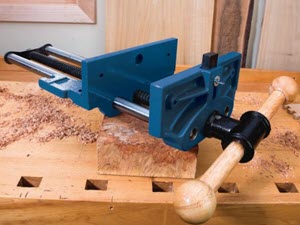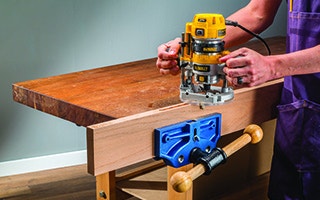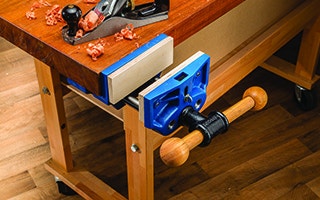Choosing A Workbench Vise For Your Shop
A solid workbench vise is like an extra set of very strong hands, and having one can actually improve your work: As long as it's attached to a sturdy workbench, a bench vise will hold a workpiece in a still and relatively vibration free state and help you make smoother saw cuts, more steady plane strokes, or even get your sanding done faster.
Even though many woodworkers would rate a workbench vise as an indispensable tool, it's an easy one to put off buying. You can get by reasonably well with an arrangement of handscrew clamps and c-clamps for a while.
But, eventually you're bound to conclude that a vise will help you hold you work steadier, in a greater variety of positions and will let you set up so much faster, that the investment is worth the price. In case you're just beginning to realize how central a bench vise is to woodworking, here's a little information to help you pick the one that makes the most sense for your shop.
There are two basic types of bench vise:
- The front vise
- The end vise
Front Vise
A front vise, like the Rockler 9" Quick Release Workbench Vise , is most often stationed at the left corner of the long edge of the work bench. A front vise is great for holding a drawer side upright while you cut the tails of a dovetail joint, or holding a board edge-up horizontally for hand planing, or for any number of other tasks that require a solid hold on the workpiece and for both of you hands to be free.

One of the most common and reliable choices for a front vise is the cast iron variety. A cast iron front vise has two jaws made of you guessed it cast iron and a steel screw to move them closer together and further apart. Most also have two steel rods to keep the jaws aligned and help to prevent flexing inward of either side of the outer jaw when only one side of the vise is used.
Some, including Rockler bench vises, have a quick release mechanism that makes it easy to switch among a variety of clamping widths. A quarter turn of the handle counter-clockwise releases the screw and allows that vise to be quickly positioned anywhere along its opening range.
Usually, the width of the jaws is used to describe the vise Rockler's 7" Quick Release Vise has 7" wide jaws, for example. You'll also almost always find the maximum opening capacity of the vise and the screw diameter also listed in the specifications. Look for a vise that opens wide enough to accommodate the thickest piece of stock you can imagine yourself working on, and remember that you will need to subtract the thickness of the of the wooden pads that you'll be installing on the jaw faces.
A 9" capacity vise with 3/4" thick pads will give you 7-1/2" to work with, which is plenty in most situations. But the odd occasion does arise when more would come in handy. A 13" opening capacity vise should have you covered for just about anything you run into.
The screw diameter and the diameter to the alignment rods make the most difference when it comes to keeping the vise's jaws parallel with one another when you tighten it down. A 7/8" diameter screw and equally husky rods offer enough rigidity to keep the jaws from flexing outward at the top under any normal working condition. Also, it's important to note that Rockler bench vises, and most other quality vises, use a toe in design, meaning that the outer jaw tilts inward slightly to account for outward flexing and to apply the greatest pressure at the top of the jaws where it is most needed.
End Vise

The other common type of workbench vise, an end vise, is stationed at one end of the workbench. Typically, the primary function of an end vise is to hold material flat on the surface of the bench, pinched between one or more "dogs" sticking up from the top surface of the vise's jaw and corresponding dogs fitted into holes in the bench surface. But the most useful type of end vise is arguably one that's set up like a front vise, with the same screw-and-two-rods design, like the Rockler Quick Release 12" End Vise End vises of this type are usually sold with just the screw and guide rod mechanism, which attaches to one end of the bench and is outfitted with a wooden jaw equal in width to the workbench.
Which Type Should You Buy?
In truth, we suspect that most woodworkers need the type of clamping arrangement a front vise was designed for more often. Many front vises, including the Rockler 7" and 9" vises, also have a pop-up dog on the outer jaw, which lets you hold a piece stock face up across the width of the table. But if you have to pick just one, keep in mind that it's awfully handy to be able to quickly and easily secure any of a variety of lengths of stock face-up on the bench. The Rockler Quick Release End Vise, along with a set of Rockler Bench Dogs, will let you do just that. The extra sturdy 12" on center guide rod placement and 13" opening capacity of the Rockler end vise mean that it will also perform "front vise tasks" admirably, giving you the best of both worlds.
Keep the inspiration coming!
Subscribe to our newsletter for more woodworking tips and tricks





